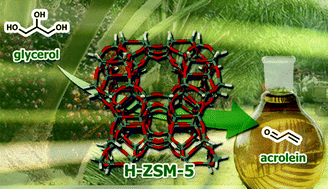Structures and reaction mechanisms of glycerol dehydration over H-ZSM-5 zeolite: a density functional theory study†
Abstract
The initial stage of glycerol conversion over H-ZSM-5

* Corresponding authors
a Laboratory for Computational and Applied Chemistry, Department of Chemistry, Faculty of Science, Kasetsart University, Bangkok 10900, Thailand
b Center for Advanced Studies in Nanotechnology and Its Applications in Chemical, Food and Agricultural Industries, Kasetsart University, Bangkok 10900, Thailand
c Center of Nanotechnology, Kasetsart University Research and Development Institute, Kasetsart University, Bangkok 10900, Thailand
d
NANOTEC Center of Nanotechnology, National Nanotechnology Center, Kasetsart University, Bangkok 10900, Thailand
E-mail:
jumas.l@ku.ac.th
Fax: +66-2562-5555 ext 2159
Tel: +66-2562-5555 ext 2176
e Institute of Ion Physics and Applied Physics, University of Innsbruck, A-6020 Innsbruck, Austria
The initial stage of glycerol conversion over H-ZSM-5

 Please wait while we load your content...
Something went wrong. Try again?
Please wait while we load your content...
Something went wrong. Try again?
K. Kongpatpanich, T. Nanok, B. Boekfa, M. Probst and J. Limtrakul, Phys. Chem. Chem. Phys., 2011, 13, 6462 DOI: 10.1039/C0CP01720E
To request permission to reproduce material from this article, please go to the Copyright Clearance Center request page.
If you are an author contributing to an RSC publication, you do not need to request permission provided correct acknowledgement is given.
If you are the author of this article, you do not need to request permission to reproduce figures and diagrams provided correct acknowledgement is given. If you want to reproduce the whole article in a third-party publication (excluding your thesis/dissertation for which permission is not required) please go to the Copyright Clearance Center request page.
Read more about how to correctly acknowledge RSC content.
 Fetching data from CrossRef.
Fetching data from CrossRef.
This may take some time to load.
Loading related content
